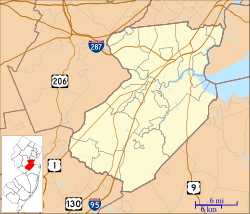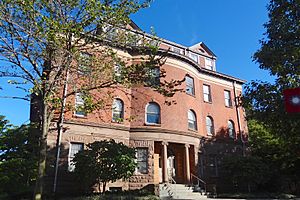Winants Hall facts for kids
Quick facts for kids |
|
|
Winants Hall
|
|
|
U.S. Historic district
Contributing property |
|
 |
|
| Location | 7 College Avenue New Brunswick, New Jersey |
|---|---|
| Built | 1890 |
| Architect | Van Campen Taylor |
| Part of | Queens Campus, Rutgers University (ID73001113) |
| Designated CP | July 2, 1973 |
Winants Hall is a historic building at Rutgers University in New Brunswick, New Jersey. It was designed by Van Campen Taylor and finished in 1890. Winants Hall was the very first dormitory, or student living building, at Rutgers University. Back then, the school was called Rutgers College.
A kind businessman named Garrett E. Winants gave the money for the building. It cost $75,000 to build. This new dorm helped the college in many ways. It also created a fun social place for students and staff. Winants Hall was a student dorm from 1890 until 1947.
Today, Winants Hall is part of the Queens Campus, Rutgers University Historic District. This district was added to the National Register of Historic Places on July 2, 1973.
A Home for Students
When Garrett E. Winants gave money for the first dorm, he had one main rule. He said the building must be used "only by the students of Rutgers College." He also said it needed to be kept in good shape by the college.
The first stone of the building was placed on June 18, 1889. This was a special day with teachers and students celebrating. By September 1890, Winants Hall was ready. It could house about 85 students. Older students got to pick their rooms first. Students paid their rent before the school year began. In 1896, Garrett E. Winants' wife, Amanda Winants, gave another $10,000. This money was just for keeping Winants Hall in good repair.
Before Winants Hall, Rutgers students lived in different places. Some lived in boarding houses, which are like rented rooms. Others traveled from home or lived in fraternity houses. Students had wanted a central place to live on campus for a long time. Winants Hall finally made their wish come true.
William H. S. Demarest, who was president of Rutgers College, wrote about this. He said Winants Hall was the "first full answer to the dormitory appeal." Having a central dorm was very important. It changed how students saw and experienced college life. Students were so happy to have their own home on campus. That year, they dedicated their yearbook, The Scarlet Letter, to Mr. Winants.
Fun and Community
A newspaper article from 1924 called Targum described life in Winants Hall. It said students had water fights! They would throw "everything from bags of water and door-loads of snow to bureaus and armchairs." These items were often thrown from the third and fourth floors. The article joked that gravity was the only law always followed in Winants.
Winants Hall had its own special culture. It was a place for students to connect outside of classes. The Targum article said Winants Hall had a big impact on the men who lived there. It helped Rutgers become a more social school. Winants Hall was also used for many other things. It hosted guests, celebrations, and dinners for alumni. The football team had dinners there, and college groups like the YMCA held meetings.
Rutgers Grows Stronger
The gift of Winants Hall came at an important time for Rutgers. The college started in 1766, founded by the Dutch Reformed Church. For many years, it struggled with money and not enough students. It even closed its doors twice.
In 1825, Rutgers College sold its property to the church to survive. Even then, student numbers kept dropping until the late 1850s. People didn't seem to care much about the college. The leaders decided to make big changes. They updated the teachers and improved the buildings. More students started coming to the college in the late 1800s.
A big reason for Rutgers' growth was a law called the Morrill Land-Grant Act of 1862. This law gave federal land to each state. The land was for colleges that would teach farming and mechanical skills. In 1864, New Jersey's land grant went to Rutgers College's new Scientific School. This grant helped Rutgers become a strong, modern college. By the 1890s, the growing school really needed a modern place for students to live. Winants Hall provided just that.
How the Building Changed
The inside of Winants Hall has changed many times. This was to meet the university's needs. When it first opened in 1890, the first floor had a dining room and meeting area. It also had student suites, which included two bedrooms and a study room. The second and third floors had more suites. The fourth floor had suites, a kitchen, laundry, and apartments for employees.
About 85 students lived in the dorm. In 1909, the dining hall was improved. In 1911 and 1915, the building got new furniture and better plumbing. Winants Hall was the only dorm at Rutgers until 1915. That's when Ford Hall was built nearby.
By 1915, some suites on the first floor became offices for the college YMCA. In the summer of 1920, Winants Hall housed students taking the first-ever summer classes at Rutgers. Later, in 1925, a new program called the Industrial Extension Division moved its offices into Winants Hall. This program taught practical skills to workers. By 1929, its offices took up a large part of the first and second floors.
Winants Hall was used as both a dorm and office space until 1947. That year, Rutgers University fully changed Winants Hall into a building for offices and school administration.
The biggest change to Winants Hall happened in 1990. This was for its 100th birthday! The project cost $9.6 million. The goal was to make the building a new center for university leaders. It would be a meeting place for the university's Boards. It would also be a center for alumni and hold various administrative offices.
During this project, the inside of the building was completely redone. It got a new steel frame to make it stronger. Even the windows were rebuilt. On the outside, workers fixed the decorative edges and cleaned the stone and stained glass windows. Inside, they restored four brick fireplaces, the marble floor, and a tall oak staircase. New fire stairs and an elevator were added. Rooms were changed to fit office needs. Winants Hall was renovated again in 2017 and 2018. Today, it is still used as an administrative building for the university.



